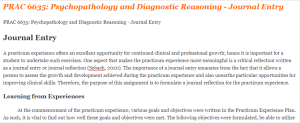PRAC 6635: Psychopathology and Diagnostic Reasoning – Journal Entry
PRAC 6635 Psychopathology and Diagnostic Reasoning – Journal Entry
Journal Entry
A practicum experience offers an excellent opportunity for continued clinical and professional growth; hence it is important for a student to undertake such exercises. One aspect that makes the practicum experience more meaningful is a critical reflection written as a journal entry or journal reflection (Sebach, 2020). The importance of a journal entry emanates from the fact that it allows a person to assess the growth and development achieved during the practicum experience and also unearths particular opportunities for improving clinical skills. Therefore, the purpose of this assignment is to formulate a journal reflection for the practicum experience.
Learning from Experiences
At the commencement of the practicum experience, various goals and objectives were written in the Practicum Experience Plan. As such, it is vital to find out how well these goals and objectives were met. The following objectives were formulated, be able to utilize autonomy when analyzing between pathophysiological and psychopathological conditions within the first month of my practicum rotation. To formulate a diagnosis every week that meets DSM 5-TR criteria for each patient’s individualized care during the period of my practicum. Identify and interpret accurate screening tools and outcomes about specific clinical situations within the first five weeks of the practicum experience. The first objective was effectively achieved by exploring how autonomy can be upheld in such situations, so I was able to utilize autonomy within the first month of the practicum. The second objective was also achieved as appropriate since I ably diagnosed patients using the DSM-5 TR criteria and suggested individualized care to the patients (Mughal et al.,2020). I was also able to interpret the screening tools for the conditions whenever called upon.
The practicum experience was not without challenges, as I experienced challenging times with some patients. One of the cases involved a forty-four-year-old female who reported to the facility with reports of social isolation and not feeling comfortable spending time with and visiting family. One of the challenging aspects of the case was the patient had several other conditions hence coming difficulty in coming up with an appropriate immediate plan. The other case was a seventeen-year-old patient with a history of seasonal affective disorder. The difficulty with this case is that the patient apparently lacked appropriate social support. The third case was that of a forty-eight-year-old patient who came to the facility displaying depression symptoms connected to the death of one of her children from cancer. The patient was so emotional and challenging to deal with.
Click here to ORDER an A++ paper from our Verified MASTERS and DOCTORATE WRITERS: PRAC 6635: Psychopathology and Diagnostic Reasoning – Journal Entry
The experience gave me a chance to learn. For example, I learned that in most cases, when a patient presents with several

symptoms which border more than two conditions, a more comprehensive assessment is needed. I used various resources which were important or key during the time. For example, the DSM-V criteria manual, peer-reviewed articles, and guidelines (Sarmiento & Lau, 2020). EBP used for the patients included proven psychiatric approaches such as cognitive behavioral therapy, family therapy, and group therapy. One of the new skills I learned is skills used in psychotherapy. If I were to have the experience again, I would do various things differently, for example, offering more holistic care. The patient’s flow and volume were managed through scheduling and appointments.
Communicating and Feedback
Even though I have acquired important skills and knowledge, these can be improved through further engagement in practical patient care and engagement. Communication with the preceptors regarding such efforts can be accomplished through phone calls and written emails. While I have improved in my diagnostic screening and reasoning, I still need to improve my cultural sensitivity and offer more holistic care.
Conclusion
The practicum experience offered me a chance to enhance my clinical diagnostic and reasoning skills. To an appreciable extent, I have achieved the formulated practicum goals and experience. While I have improved in several aspects, I still need to enhance some aspects, such as offering holistic care and cultural sensitivity.
PRAC 6635: Psychopathology and Diagnostic Reasoning – Journal Entry References
Mughal, A. Y., Devadas, J., Ardman, E., Levis, B., Go, V. F., & Gaynes, B. N. (2020). A systematic review of validated screening tools for anxiety disorders and PTSD in low to middle-income countries. BMC Psychiatry, 20, 1–18. https://doi.org/10.1186/s12888-020-02753-3
Sarmiento, C., & Lau, C. (2020). Diagnostic and statistical manual of mental disorders: DSM‐5. The Wiley Encyclopedia of Personality and Individual Differences: Personality Processes and Individual Differences, 125-129. https://doi.org/10.1002/9781119547174.ch198
Sebach, A. M. (2020). Using Flipgrid as an alternative to journals during DNP practicum experiences. Nurse Educator, 45(5), 256. Doi: 10.1097/NNE.0000000000000812

